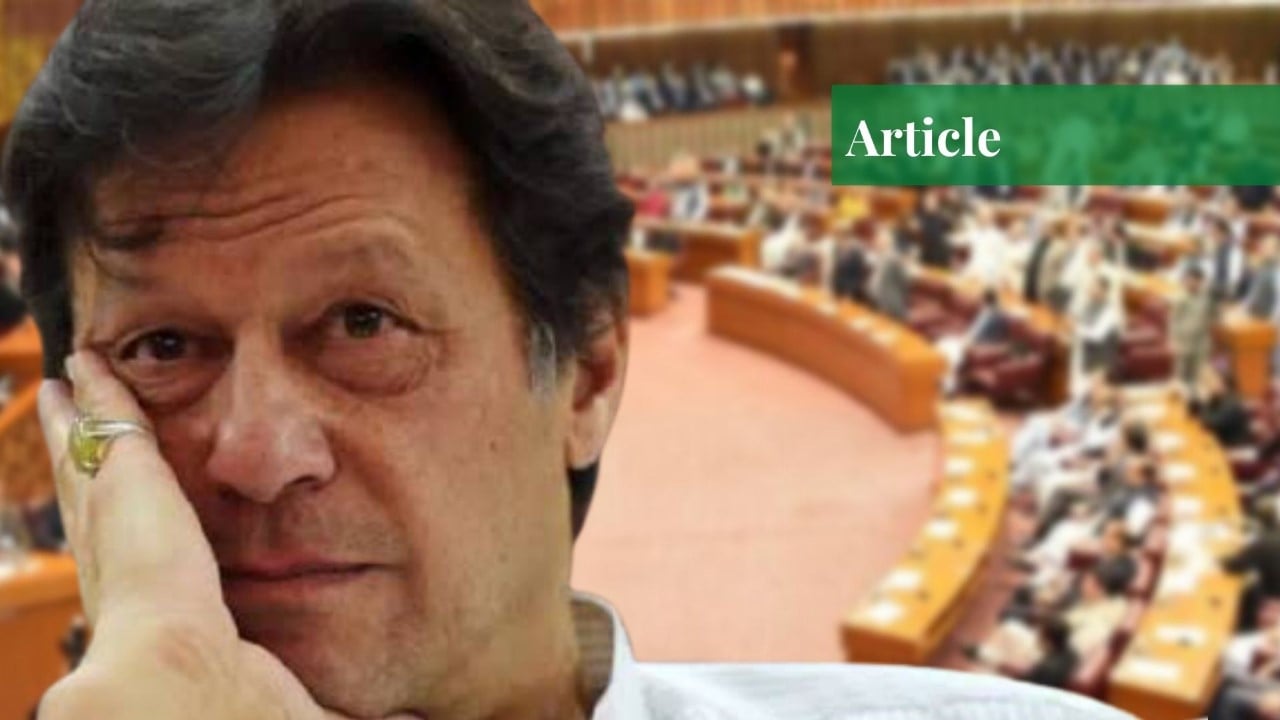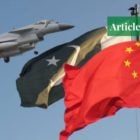Ms Afifa Iqbal has a keen interest in identity politics, colonialism and post-colonial development. She is currently working as a Research Assistant at ITU while pursuing her postgraduate studies in Development, Technology and Policy. She is a Gold Medalist in Political Science from the University of Punjab.
Political Theatre
Politics is the greatest of all theatres. Alongside their roles, the performers must understand the stage on which they are performing, because, unlike other theatrical performances, the stakes are much higher and a single misstep can yield catastrophic results. History is replete with such examples – errors made by key political performers culminated in the collapse of the entire stage.
Despite being center-stage, Pakistani Prime Minister Imran Khan not only took many sidesteps but has also seemingly failed to understand the stage he was performing on. Consequently, he is now facing the ‘no-confidence’ motion against him in the National Assembly.
The outcome of the no-confidence motion becomes tangential when one analyzes the approach of Prime Minister Imran Khan towards his premiership. Whether he ends up winning the no-confidence motion or losing it, his political legacy has shaped up to be that of a demagogue.
Before explaining the current scenario further, it seems pertinent to contextualize the argument by describing how the no-confidence motion proceeds as well as its history in Pakistan.
No-confidence Motion
Step 1: In the first phase, as per Section 36 of the National Assembly Rules, the notice for the no-confidence motion is tabled by the movers of the resolution. The notice must be supported by at least 20% of the total members of the National Assembly. In addition to this, the movers must also requisition the lower house if it’s not in session as per Article 54.
The requisition request has to be signed by 25% of the total members of the National Assembly. The opposition alliance has taken this first step and submitted 2 motions: the notice for the no-confidence motion and the requisition for the National Assembly session.
Step 2: After the requisition request has been submitted, the speaker has to convene a session at the National Assembly within 14 days. The place and time can be decided by the speaker.
Step 3: After a session of the National Assembly is convened, the notice for no-confidence motion is circulated and the resolution is moved to the next working day. During this phase, one of the movers will move the resolution by ‘seeking leave’ of the House.
The leave has to be supported by the majority of the members present and voting as per Article 55. If the leave fails to get the support of the majority of the members present and voting, then the motion dies. Otherwise, one of the movers is again asked to stand up and formally move the resolution.
Step 4: During this phase, the discussion on the motion is carried out. For this purpose, the speaker can allot one or more days. The movers of the resolution as well as those against him are given a chance to justify their position. The speaker decides who will speak and for how long.
Step 5: According to the rules of procedure, the voting cannot be scheduled before three days or later than seven days after the passing of the resolution. Finally, the voting process begins on the designated day and time via ‘open vote by division’. Two exits are prepared with tellers stationed near each of them.
The members who are for the motion exit through one door and those who are against the motion exit through the other. The tellers confirm names and keep the count. Once all the members have left, the voting is closed. The speaker, then, calls the member back into the house and announces the result. If the vote is successful, the prime minister ceases to hold office.
Past Instances
As chaotic as Pakistan’s politics is, the no-confidence motion has never been successful. What’s even more intriguing is the fact that before Imran Khan, it has only been brought up against two sitting premiers. The no-confidence motion was tabled for the first time against Benazir Bhutto in 1989 and then against Shaukat Aziz in 2006. Both survived the vote. This contextualization offers a better vantage point to understand the two key mistakes made by Imran Khan.
Mistake 1: Not Understanding the Stage
Chaos. Complete and utter chaos. If there ever was a word to describe the essence of Pakistani politics, then, it would be chaos. And within this chaos, democratic forces are in constant struggle. However, the democratic forces have also started to gain a bit of traction in the society with the revival of civil society which includes leftist activists, student activists, and social justice advocates.
That being said, there are two biggest obstacles that the democratic forces have to face: the democratic institution didn’t go through the process of indigenization in Pakistan like many other post-colonial states, and consequently, democracy has not been socially embedded in the Pakistani society. And the result of these obstacles is pretty clear.
Even in the post-Musharraf era, there are powers that can seep into the democratic arena through the interstices within the democratic boundary. The easiest way to stop this interstitial flow would have been to strengthen the bond amongst the democratic forces that exist both in the form of civil society and elected representatives.
This is not to argue that Prime Minister Imran Khan should form a ‘brother-in-arms’ relationship with the aforementioned political performers, but that he should have a working relationship with them. Again, to reiterate an earlier point, this does not mean that the other key performers were or are flawless.
They can easily be credited with the propagation of dynastic politics, strengthening the patron-client polity and economy, and appropriation of state resources. However, it was still the responsibility of Prime Minister Imran to understand the narrative and realize the importance of collaboration in not only strengthening his performance but also in navigating the tricky bits of the narrative. As Shakespeare wrote, “Uneasy lies the head that wears a crown.”
Then there exists the issue of Punjab. Punjab is a province that has PMLN and Shahbaz Sharif’s footprints all over it. From technology parks to the provision of basic social services, Shahbaz Sharif (discounting his political flaws) was able to manage the province in a nice enough manner. And this is why Prime Minister Imran Khan’s choice of the Chief Minister candidate i.e. Usman Buzdar for this province has and will continue to hurt him.
When a common man gets out of his house, he can see the deteriorating quality of the basic services – sanitation, for example. To him, Prime Minister Imran Khan’s vision of ‘Naya Pakistan’ holds little meaning when in ‘Old Pakistan’ his street would be clean and the trash cans at the corner of that street would be empty.
Mistake 2: Not Understanding the Role
If not understanding the nature of the stage was a problem that has plagued Prime Minister Imran Khan’s four-year rule, then, not understanding the way his performance is meant to be has been an even bigger problem. The weaponization of political language and ad hominem might have served him well during the election campaign, but this ‘gotcha!’ attitude doesn’t really work in the PM office.
In order to serve the people and make good on one’s promises in a representative democracy (or even a façade of it), one has to collaborate with one’s opponents in one way or another, but the way Prime Minister Imran Khan has continued to address his opponents is really distasteful and doesn’t sit well with his office.
Another problem that’s pretty close to the aforementioned problem is Prime Minister Imran Khan’s ‘know-it-all’ attitude. From claiming to know more about the culture of a state than its natives to making claims about understanding the West better than any other person, his statements have become the fuel for Twitter memes among the youth – his primary audience and voter base.
This, ultimately, violates the decorum of the office he’s occupying and makes it hard for the educated citizenry, particularly the young educated citizenry, to take his statements seriously. Another problem that has cropped its head up time and again during Prime Minister Imran Khan’s tenure is the externalization of blame.
The way PTI members have been linking this no-confidence motion to a foreign conspiracy is not doing them any good. While the claims that ‘foreign powers’ are against Khan due to his tilt toward the budding Pakistan-Russia-China bloc could possibly have some merit, some proof is necessary to convince the masses. Incessant peddling of conspiracy theories further erodes the confidence of the citizenry about democratic institutions.
Finally, even if that were the case, it pays well to remember Kermit Roosevelt Jr., an American intelligence officer, who allegedly stated (after orchestrating a successful coup in Iraq) that they cannot create a situation; they can only exploit a situation. So, even if the conspiracy theory claim is correct, Prime Minister must reflect upon this question: “Who is responsible for creating a situation that could be exploited by his enemies who exist outside the border?”
What Happens Next?
The opposition, if joint, has a strength of almost 163, but is working on building a majority by enticing PTI MNAs monetarily. Since allegedly 12-24 members of the ruling Pakistan Tehreek-e-Insaf (PTI) were recently present in the Sindh House (having apparently defected from PTI), it will now be interesting to see how the MNAs from all parties vote during the no-confidence proceedings.
PTI, which has 155 seats in the lower house, will fall short of the 172 needed to stay in power without the coalition partners and dissidents. PM Imran Khan has now been working on figuring out legal ways to make moves against these defectors, and Supreme Court Justice Munib Akhtar recently observed that according to Article 95(ii) of the Constitution, which deals with the procedure to bring in a no-confidence motion against the prime minister, a member’s individual vote had “no status”. However, the court has not issued a final order yet.
If you want to submit your articles, research papers, and book reviews, please check the Submissions page.
The views and opinions expressed in this article/paper are the author’s own and do not necessarily reflect the editorial position of Paradigm Shift.



















